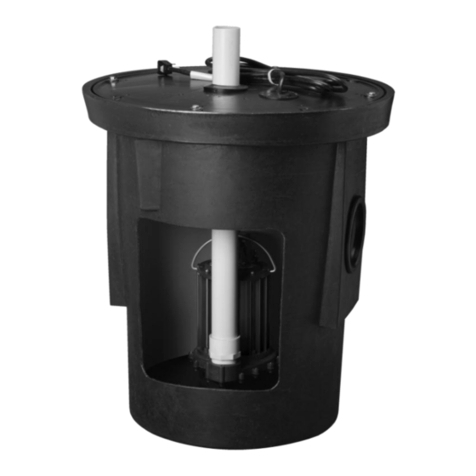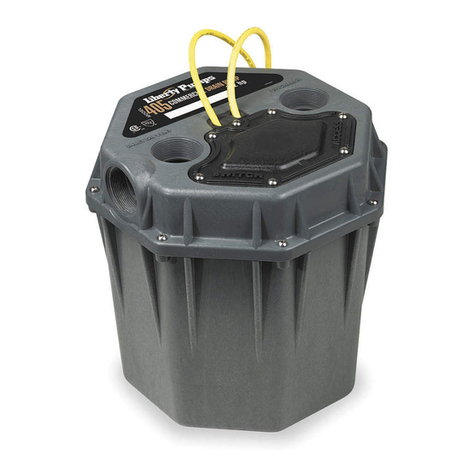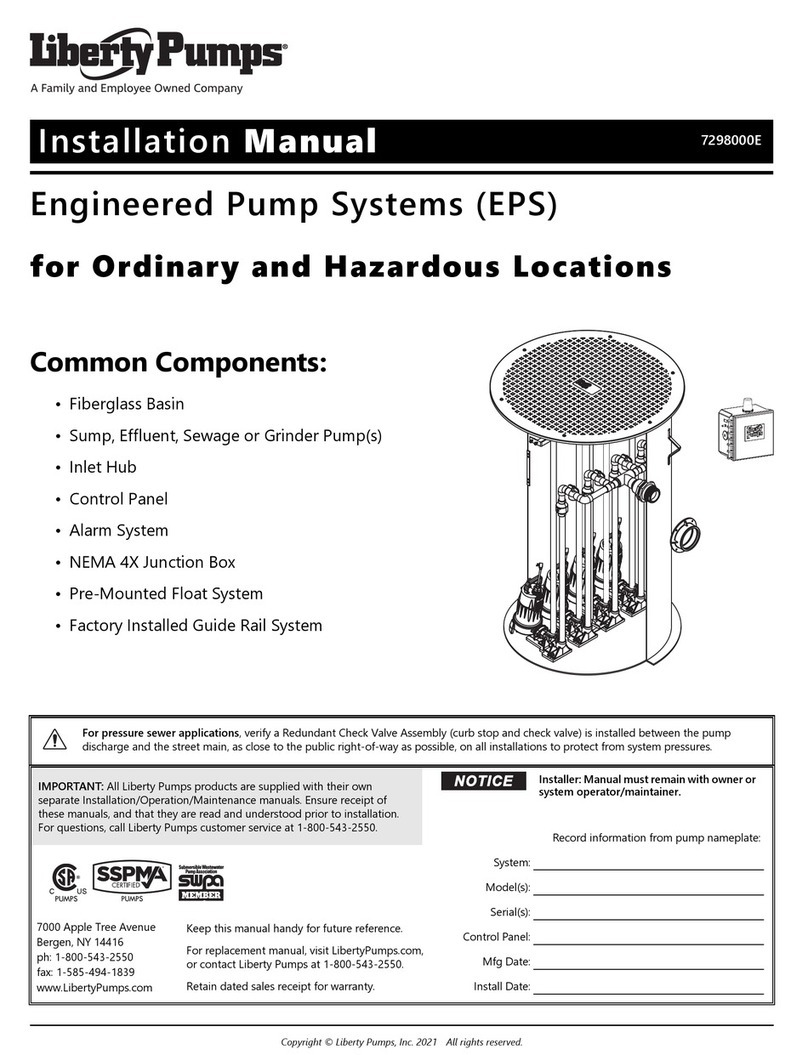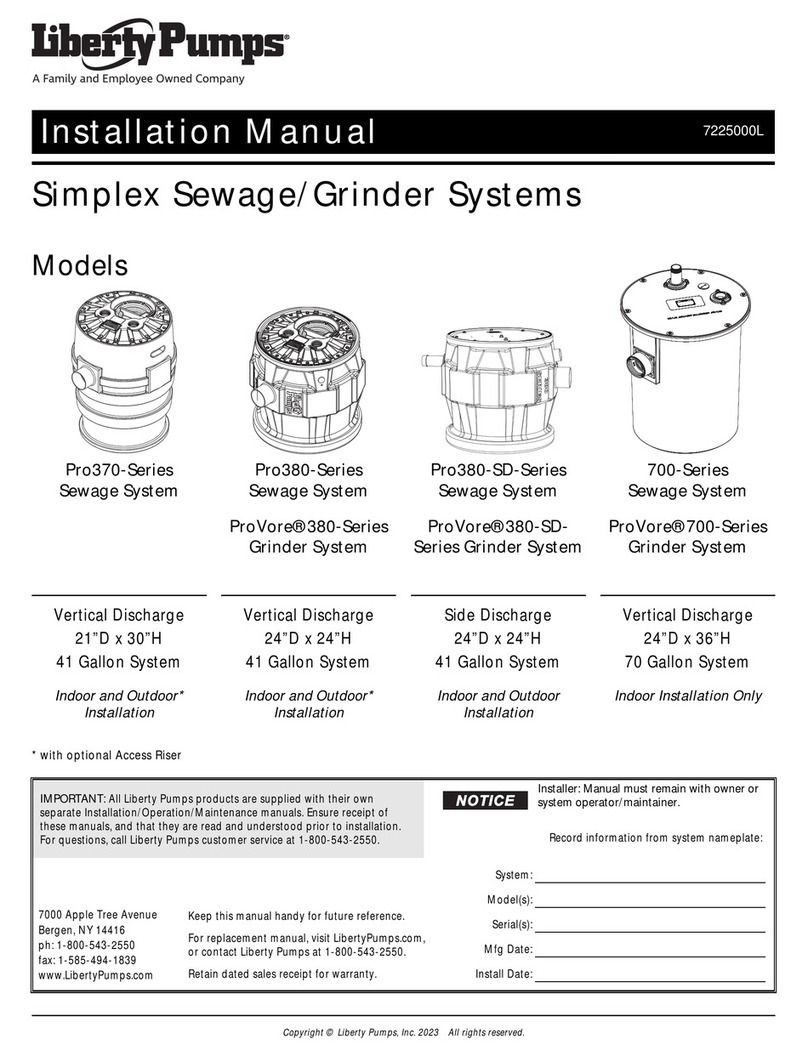
3473000C Copyright © Liberty Pumps, Inc. 2021
All rights reserved. 3 | EN
This product requires a separate, properly fused and
grounded branch circuit, sized for the voltage and amperage
requirements of the pump, as noted on the nameplate.
Overloaded branch circuit wires will get very hot and can
catch on fire. When used, electrical outlets shall be simplex of
the appropriate rating.
Sewage and effluent systems produce and may contain
flammable and explosive gases. Prevent introduction of
foreign objects into basin as sparks could ignite these gases.
Exercise caution using tools and do not use electronic devices
or have live, exposed electrical circuits in or around basins,
open covers and vents.
Hazardous locations contain explosive gases that can be
detonated by sparking or electric shock.
All terminations and penetrations of conduit or cable shall be
done using approved materials and methods intended for use
to mitigate the potential for explosion.
When working in a hazardous location, all precautions to
minimize ignition sources such as spark and flame should be
taken to limit the potential for fire or explosion.
Use only non-sparking tools and components in and around
basins, open covers and vents. Do not use electronic devices
that are not rated for use in hazardous locations or have live,
exposed electrical circuits in or around basins, open covers
and vents. Sewage and effluent systems produce and may
contain flammable and explosive gases and sparks could
ignite these gases.
Energizing the control panel or breaker for the first time is
potentially dangerous. Licensed electrical personnel should
be present when the panel or breaker is energized for the first
time. If faults caused by damage or poor installation practices
have not been detected, serious damage, injury or death can
result when power is applied.
All electrical and motor repairs and service must be
performed by a repair facility approved by Liberty Pumps and
certified to work on explosion-proof motor enclosures.
Do not remove power supply or control cord.All electrical and
motor repairs and service must be performed by the factory
or a repair facility approved by Liberty Pumps and certified to
work on explosion-proof motor enclosures.
Refer to Chapter 5 of the National Electric Code®or
applicable local codes and ordinances for all electrical and
wiring requirements in hazardous locations.
Float switches must be connected to an intrinsically safe
circuit in the control panel as per the requirements of
Chapter 5 of the National Electric Code®.
All personnel shall be trained and qualified for safe work
practices and procedures.
All installations shall be in compliance with all applicable
Federal, State, and Local codes and ordinances for hazardous
locations.
All electrical terminations shall be made according to Federal,
State, and Local codes for hazardous or classified locations.
Conduit, junction boxes, and associated components shall be
approved for use with hazardous locations and installed
according to specifications.
Do not modify the pump/pump system in any way.
Modifications may affect seals, change the electrical loading
of the pump, or damage the pump and its components.
Do not allow children to play with the pump system.
Do not allow any person who is unqualified to have contact
with this pump system. Any person who is unaware of the
dangers of this pump system, or has not read this manual, can
easily be injured by the pump system.
All pump/pump system installations shall be in compliance
with all applicable Federal, State, and Local codes and
ordinances.
In 208/230V installations, one side of the line going to the
pump is always “hot”, whether the float switch is on or off. To
avoid hazards, install a double pole disconnect near the pump
installation.
Vent basin in accordance with local code. Proper venting of
sewer and effluent gases alleviates poisonous gas buildup
and reduces the risk of explosion and fire from these
flammable gases.
Wear adequate Personal Protective Equipment when working
on pumps or piping that have been exposed to wastewater.
Sump and sewage pumps often handle materials that can
transmit illness or disease upon contact with skin and other
tissues.
Do not remove any tags or labels from the pump or its cord.
Do not enter a pump basin after it has been used. Sewage and
effluent can emit several gases that are poisonous.
Keep clear of suction and discharge openings. To prevent
injury, never insert fingers into pump while it is connected to
a power source.
This product contains chemicals known to the State of
California to cause cancer and birth defects or other
reproductive harm. www.p65warnings.ca.gov.
This pump has been evaluated for use with water only,
however use with human waste and toilet paper is permitted.
Check 3-phase pumps for correct rotation prior to installing
pump(s) in basin. To change rotation, reverse any two of the
three power leads to the pump (not the ground). Code the
wires for reconnection after installation.
Do not dispose of materials such as paint thinner or other
chemicals down drains. Doing so could chemically attack and
damage pump system components and cause product
malfunction or failure.
Do not use pumps with fluid over 104°F (40°C). Operating the
pump in fluid above this temperature can overheat the pump,
resulting in pump failure.
Do not use pump system with mud, sand, cement,
hydrocarbons, grease, or chemicals. Pump and system
components can be damaged from these items causing
product malfunction or failure. Additionally, flooding can
occur if these items jam the impeller or piping.
RISK OF SERIOUS INJURY OR DEATH



















































